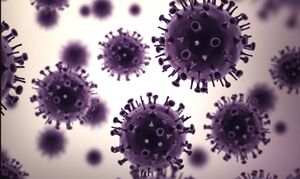Canine influenza: Difference between revisions
No edit summary |
|||
| (12 intermediate revisions by one other user not shown) | |||
| Line 1: | Line 1: | ||
[[Category:Very short pages]] | |||
{{Uncurated}} | {{Uncurated}} | ||
[[Image: | [[Image:Canineinfluenza.jpg|thumb|300px|right|Legend. Image credit: CliniciansBrief.]] | ||
| Line 9: | Line 10: | ||
Domain; | Domain; Unranked; Virus Phylum; Negarnaviricota Class; Insthoviricetes Order; Articulavirales family; Orthomyxoviridae [Others may be used. Use [http://www.ncbi.nlm.nih.gov/Taxonomy/ NCBI] link to find] | ||
| Line 15: | Line 16: | ||
===Species=== | ===Species=== | ||
{| | {|H3N8 Virus | ||
| height="10" bgcolor="#FFDF95" | | | height="10" bgcolor="#FFDF95" | | ||
| Line 31: | Line 32: | ||
==Genome Structure== | ==Genome Structure== | ||
Single stranded negative sense RNA, 8 chromosomes | Single stranded negative sense RNA, 8 chromosomes and circular | ||
==Cell Structure, Metabolism and Life Cycle== | ==Cell Structure, Metabolism and Life Cycle== | ||
| Line 39: | Line 38: | ||
18 hemagglutinin molecules attached on the outer layer along with 6 neuramindase molecules. Surrounded with a lipid bilayer and matrix protein (m1), containing nucleoproteins and RNA polymerase in the center. Gains energy from host cells. | 18 hemagglutinin molecules (HA) attached on the outer layer along with 6 neuramindase molecules (NA). Surrounded with a lipid bilayer and matrix protein (m1), containing nucleoproteins and RNA polymerase in the center. Gains energy from host cells. | ||
==Ecology and Pathogenesis== | ==Ecology and Pathogenesis== | ||
Virus effects and disrupts the immune system of Canines, Pigs, Horses, Ducks, negative symbiotic relationship disrupts immune system, symptoms appear as cough, excessive mucus, fever, lethargy, discharge from eyes, decreased appetite. Advancement in infection can lead to pneumonia. | |||
==References== | |||
Yang, H., Nguyen, H. T., Carney, P. J., Guo, Z., Chang, J. C., Jones, J., ... & Stevens, J. (2015). Structural and functional analysis of surface proteins from an A (H3N8) influenza virus isolated from New England harbor seals. Journal of Virology, 89(5), 2801-2812. | |||
Wahlgren, J. (2011). Influenza A viruses: an ecology review. Infection ecology & epidemiology, 1(1), 6004. | |||
==Author== | ==Author== | ||
Page authored by | Page authored by Daniel LoBocchiaro, student of Prof. Bradley Tolar at UNC Wilmington. | ||
<!-- Do not remove this line-->[[Category:Pages edited by students of Bradley Tolar at UNC Wilmington]] | <!-- Do not remove this line-->[[Category:Pages edited by students of Bradley Tolar at UNC Wilmington]] | ||
Latest revision as of 19:30, 21 May 2024
Classification
Domain; Unranked; Virus Phylum; Negarnaviricota Class; Insthoviricetes Order; Articulavirales family; Orthomyxoviridae [Others may be used. Use NCBI link to find]
Species
|
NCBI: [1] |
Genus species
Description and Significance
Enters organism through inhalation and embeds in the respiratory mucosa, effecting the upper and lower respiratory tract. Virus attaches to epithelial cells due to the binding of the hemagglutinin spike protein to the N-acetylneuraminic acid receptor. Virus then invades cell by endocytosis into the cell cytoplasm, where new virions are replicated and released back into the respiratory tract. The viruses spreads through the trachea within 4 days of exposure and causes swelling, necrosis, flaking of skin, and bone deterioration.
Genome Structure
Single stranded negative sense RNA, 8 chromosomes and circular
Cell Structure, Metabolism and Life Cycle
18 hemagglutinin molecules (HA) attached on the outer layer along with 6 neuramindase molecules (NA). Surrounded with a lipid bilayer and matrix protein (m1), containing nucleoproteins and RNA polymerase in the center. Gains energy from host cells.
Ecology and Pathogenesis
Virus effects and disrupts the immune system of Canines, Pigs, Horses, Ducks, negative symbiotic relationship disrupts immune system, symptoms appear as cough, excessive mucus, fever, lethargy, discharge from eyes, decreased appetite. Advancement in infection can lead to pneumonia.
References
Yang, H., Nguyen, H. T., Carney, P. J., Guo, Z., Chang, J. C., Jones, J., ... & Stevens, J. (2015). Structural and functional analysis of surface proteins from an A (H3N8) influenza virus isolated from New England harbor seals. Journal of Virology, 89(5), 2801-2812.
Wahlgren, J. (2011). Influenza A viruses: an ecology review. Infection ecology & epidemiology, 1(1), 6004.
Author
Page authored by Daniel LoBocchiaro, student of Prof. Bradley Tolar at UNC Wilmington.

